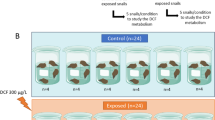Abstract
Methoxychlor [1,1,1-trichloro-2,2-bis(p-methoxyphenyl)ethane], a substitute for 1,1,1-trichloro-2,2-bis(p-chlorophenyl)ethane (DDT), is a compound of environmental concern because of potential long-term health risks related to its endocrine-disrupting and carcinogenic potency. In order to determine the metabolic fate of methoxychlor and DDT in the human intestinal gut, Eubacterium limosum (ATCC 8486), a strict anaerobe isolated from the human intestine that is capable of O-demethylation toward O-methylated isoflavones, was used as a model intestinal microbial organism. Under anaerobic incubation conditions, E. limosum completely transformed methoxychlor and DDT in 16 days. Based on gas chromatography–mass chromatography analyses, the metabolites produced from methoxychlor and DDT by E. limosum were confirmed to be 1,1-dichloro-2,2-bis(p-methoxyphenyl)ethane (methoxydichlor) and 1,1-dichloro-2,2-bis(p-chlorophenyl)ethane (DDD), respectively. This study suggests that E. limosum in the human intestinal gut might be a participant in the reductive dechlorination of methoxychlor to the more antiandrogenic active methoxydichlor.





Similar content being viewed by others
References
Ahuja R, Kumar A (2003) Metabolism of DDT [1,1,1-trichloro-2,2-bis(4-chlorophenyl)ethane] by Alcaligenes denitrificans ITRC-4 under aerobic and anaerobic conditions. Curr Microbiol 46:65–69
Anway MD, Cupp AS, Uzumcu M, Skinner MK (2005) Epigenetic transgenerational actions of endocrine disruptors and male fertility. Science 308:1466–1469
Baarschers WH, Bharath AI, Elvish J, Davies M (1982) The biodegradation of methoxychlor by Klebsiella pneumoniae. Can J Microbiol 28:176–179
Chapin RE, Harris MW, Davis BJ, Ward SM, Wilson RE, Mauney MA, Lockhart AC, Smialowicz RJ, Moser VC, Burka LT, Collins BJ (1997) The effects of perinatal/juvenile methoxychlor exposure on adult rat nervous, immune, and reproductive system function. Fundam Appl Toxicol 40:138–157
Clark AG, Shamaan NA (1984) Evidence that DDT-dehydrochlorinase from the housefly is a glutathione S-transferase. Pesticide Biochem Physiol 22:249–261
Cocco P (2002) On the rumors about the silent spring. Review of the scientific evidence linking occupational and environmental pesticide exposure to endocrine disruption health effects. Cad Saude Publica 18:379–402
Cummings AM (1997) Methoxychlor as a model for environmental estrogens. Crit Rev Toxicol 27:367–379
Dull BJ, Salata K, Goldman P (1987) Role of the intestinal flora in the acetylation of sulfasalazine metabolites. Biochem Pharmacol 36:3772–3774
Fisher JS (2004) Environmental anti-androgens and male reproductive health: focus on phthalates and testicular dysgenesis syndrome. Reproduction 127:305–315
Fogel S, Lancione RL, Sewall AE (1982) Enhanced biodegradation of methoxychlor in soil under sequential environmental conditions. Appl Environ Microbiol 44:113–120
Fort DJ, Guiney PD, Weeks JA, Thomas JH, Rogers RL, Noll AM, Spaulding CD (2004) Effect of methoxychlor on various life stages of Xenopus laevis. Toxicol Sci 81:454–466
Gaido KW, Leonard LS, Maness SC, Hall JM, McDonnell DP, Saville B, Safe S (1999) Differential interaction of the methoxychlor metabolite 2,2-bis-(p-hydroxyphenyl)-1,1,1-trichloroethane with estrogen receptors alpha and beta. Endocrinology 140:5746–5753
Herrera A, Arino P, Conchello P, Lazaro R, Bayarri S, Perez-Arquillue C, Garrido D, Jodral M, Pozo R (1996) Estimates of mean daily intakes of persistent organochlorine pesticides from spanish fatty foodstuffs. Bull Environ Contam Toxicol 56:173–177
Hirai H, Nakanishi S, Nishida T (2004) Oxidative dechlorination of methoxychlor by ligninolytic enzymes from white-rot fungi. Chemosphere 55:641–645
Hur HG, Rafii F (2000) Biotransformation of the isoflavonoids biochanin A, formononetin, and glycitein by Eubacterium limosum. FEMS Microbiol Lett 192:21–25
Jandacek RJ, Tso P (2001) Factors affecting the storage and excretion of toxic lipophilic xenobiotics. Lipids 36:1289–1305
Kitamura S, Shimizu Y, Shiraga Y, Yoshida M, Sugihara K, Ohta S (2002) Reductive metabolism of p,p′-DDT ad o,p′-DDT by rat liver cytochrome P450. Drug Metabol Dispos 30:113–118
Llados F, Sage G, Citra M, Gefell D (2002) Toxicological profile for DDT, DDE and DDD (Update). TP-35. Agency for Toxic Substances and Disease Registry, US Department of Health and Human Services, Atlanta, GA
Mendel JL, Walton MS (1966) Conversion of p,p′-DDT to p,p′-DDD by intestinal flora of the rat. Science 151:1527–1528
Nonaka H, Keresztes G, Shinoda Y, Ikenaga Y, Abe M, Naito K, Inotomi K, Furukawa K, Inri M, Yukawa H (2006) Complete genome sequence of the dehalorespiring bacterium Desulfitobacterium hafniense Y51 and comparison with Dehalococcoides ethenogenes 195. J Bacteriol 188:2262–2274
Peppercorn MA, Goldman P (1971) Caffeic acid metabolism by bacteria of the human gastrointestinal tract. J Bacteriol 108:996–1000
Saka M (2003) Developmental toxicity of p,p′-dichlorodiphenyltrichloroethane, 2,4,6-trinitrotoluene, their metabolites, and benzopyrene in Xenopus laevis embryos. Environ Toxicol Chem 23:1065–1073
Simon GL, Gorbach SL (1986) The human intestinal microflora. Dig Dis Sci 31:147S–162S
Staub C, Hardy VB, Chapin RE, Harris MW, Johnson L (2002) The hidden effect of estrogenic/antiandrogenic methoxychlor on spermatogenesis. Toxicol Appl Pharmacol 180:129–135
Stuchal LD, Kleinow KM, Stegeman JJ, James MO (2006) Demethylation of the pesticide methoxychlor in liver and intestine from untreated, methoxychlor-treated and 3-methylcholanthrene-treated channel catfish (Ictalurus punctatus): evidence for roles of CYP1 and 3A family isozymes. Drug Metab Dispos 34:932–938
Sugihara K, Kitamura S, Ohta S (1998) Reductive dechlorination of DDT to DDD by rat blood. Biochem Mol Biol Int 45:85–91
Sung Y, Ritalahti KM, Sanford RA, Urbance JW, Flynn SJ, Tiedje JM, Loffler FE (2003) Characterization of two tetrachloroethene-reducing, acetate-oxidizing anaerobic bacteria and their description as Desulfuromonas michiganensis sp. nov. Appl Environ Microbiol 69:2964–2974
Wackett LP, Sadowsky MJ, Newman LM, Hur HG, Li S (1994) Metabolism of polyhalogenated compounds by a genetically engineered bacterium. Nature 368:627–629
Wolfe NL, Zepp RG, Paris DE, Boughman GL (1977) Methoxychlor and DDT degradation in water rates and products. Environ Sci Technol 11:1077–1081
Acknowledgments
We thank Dr. R. A. Kanaly at Kyoto University, Japan for editorial comments. This work was supported by grants from the MOST/KOSEF to the Environmental Biotechnology National Core Research Center (grant No. R15-2003-012-02002-0) of Korea and the Sustainable Water Resources Research Center of 21st Century Frontier R&D program through the Center for Water Research at Gwangju Institute of Science and Technology in Korea.
Author information
Authors and Affiliations
Corresponding author
Rights and permissions
About this article
Cite this article
Yim, YJ., Seo, J., Kang, SI. et al. Reductive Dechlorination of Methoxychlor and DDT by Human Intestinal Bacterium Eubacterium limosum Under Anaerobic Conditions. Arch Environ Contam Toxicol 54, 406–411 (2008). https://doi.org/10.1007/s00244-007-9044-y
Received:
Accepted:
Published:
Issue Date:
DOI: https://doi.org/10.1007/s00244-007-9044-y




